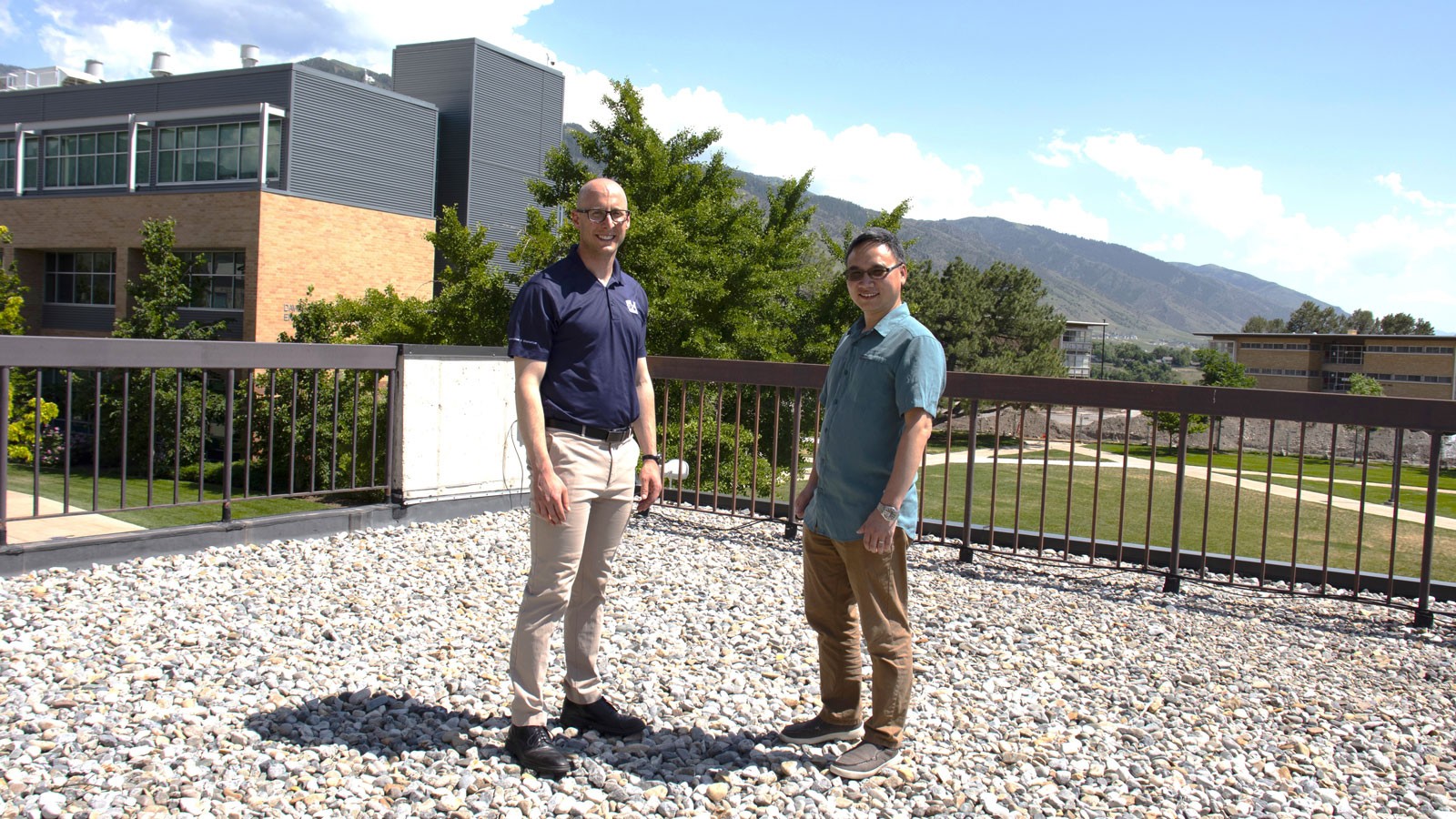Recipe for Safety: USU Scientists Receive NOAA Grant to Study Extreme Snow Loads
Statistician Brennan Bean, climate scientist Wei Zhang team to provide information for building-code engineers.
By Mary-Ann Muffoletto |
Statistician Brennan Bean and climate scientist Wei Zhang.
Utah’s 2022-23 meteorological winter was one of the wettest ever recorded in the Beehive State. While the generous precipitation was a welcome boost to dry reservoirs and groundwater supplies, the massive snowfall brought its share of headaches for property owners. In Park City, multiple structures collapsed from heavy snowfall, and more homes, barns, sheds and other structures followed in other parts of the state. Residents in several Utah locations were forced to evacuate their homes as a precaution, as winter storms repeatedly pummeled the state with mixes of rain and snow.
Utah isn’t the only place impacted by heavy snowfall, and Utah State University scientists Brennan Bean and Wei Zhang are among researchers investigating how to determine precautions needed in a changing climate. The pair, with colleagues from the University of Colorado Boulder, the University of Nebraska-Lincoln and the Reno, Nevada-based Desert Research Institute, received more than $593,000 over three years from the National Oceanic and Atmospheric Administration (NOAA). USU’s portion of the grant is over $300,000 for the project titled Understanding the Evolving Threat of Snow Loads and Rain on Snow Events to Structural Safety, to study how peak snow loads could evolve over time.
“Lots of people have a misconception that because the world is warming, we will have less snow,” says Bean, assistant professor in the Department of Mathematics and Statistics and lead principal investigator on the NOAA-funded project. “But the warmer the planet becomes, the more moisture the atmosphere can take up and release as precipitation.”
Bean says that while typical snow loads — that is, the weight of snow on the roof of a structure — may, on average, be falling, variability in extreme snow loads appears to be increasing.
“Our goal with this project is to determine how peak snow loads will change in the future,” he says. “Our intent is to use historical climate information to determine the ‘ingredients’ of extreme snow loading, which include precipitation, temperature, humidity and radiation. Then, we can estimate future extreme snow loads based on these ingredients as obtained from future climate projections.”
The team’s predictions will be used to adjust building standards throughout the United States to help ensure structures can safely withstand accumulation from future winter storms. Zhang, an assistant professor of climate science in USU’s Department of Plants, Soils and Climate, will work with NOAA data, but there are challenges to overcome.
“Many U.S. climate models cannot simulate rain/snow events, and we need to downscale the data we have to get a much higher resolution,” Zhang says. “Down to about 4-kilometer resolution, which is still a large area.”
Bean added that there are good 50-kilometer global climate models, “but that’s like all of northern Utah, and that’s not going to work for determining building codes. We need to make the resolution fine enough to be actionable.”
The research team will use statistical downscaling, a way of developing statistical relationships between historic, observed climate data in a location and the results of a climate model developed for the same historical period. That allows researchers to make predictions for future rain/snow events which are expected to become more frequent.
Bean, who has experience working on American Society of Civil Engineers committees that set minimum design load requirements for structures, says that from a structural standpoint, rain on snow is very different from just snow on a roof.
“Snow soaks up the water, which creates a lot of weight before it sheds,” Bean says. “The risk of collapse is in the period when the snow is acting like a sponge and not like an ice cube.”
The researchers have a big job ahead determining the magnitude and frequency of extreme rain/snow load events. Bean adds that while engineers would love to have a single design snow load value to use when designing a structure in a specific location, that may not be a realistic expectation in a changing climate. However, it’s important to move forward to develop new codes.
“We have great partners and we’re working out how to take all this data and climate science and the changing frequency of rain on snow and distill it to a number or factor that engineers can use to say, ‘To the best of our ability, we can get to this level of safety,’” Bean says.
Although there are uncertainties, it’s important to get to work now because the climate continues to change, and it could take a decade or longer for policies and building codes to adjust based on the researchers’ work.
“There are always people who will say climate data is too uncertain,” Bean says. “But buildings have to be built today and if we keep waiting for the perfect answer, we’re going to have no answer.”
WRITER
Mary-Ann Muffoletto
Public Relations Specialist
College of Science
435-797-3517
maryann.muffoletto@usu.edu
CONTACT
Brennan Bean
Assistant Professor
Department of Mathematics and Statistics
435-797-4130
brennan.bean@usu.edu
Wei Zhang
Assistant Professor
USU Dept. of Plants, Soils & Climate
(435)797-1101
wei.zhang@usu.edu
Lynnette Harris
Marketing and Communications
College of Agriculture and Applied Sciences
435-764-6936
lynnette.harris@usu.edu
TOPICS
Environment 263stories STEM 163stories Climate 151storiesComments and questions regarding this article may be directed to the contact person listed on this page.







